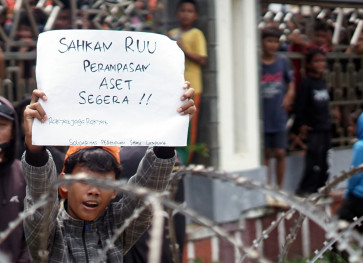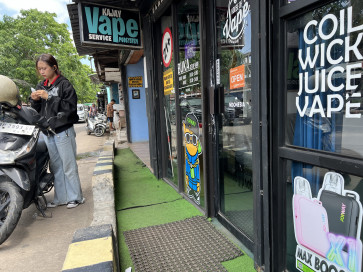Popular Reads
Top Results
Can't find what you're looking for?
View all search resultsPopular Reads
Top Results
Can't find what you're looking for?
View all search results40 years of Erasmus Huis: Celebrating Multiculturalism
Birthday bash: Dancer and choreographer Siko Setyanto (from left to right) and two other dancers David and Mislam perform Synergy at the Erasmus Huis auditorium in Jakarta, on April 10
Change text size
Gift Premium Articles
to Anyone
B
span class="caption">Birthday bash: Dancer and choreographer Siko Setyanto (from left to right) and two other dancers David and Mislam perform Synergy at the Erasmus Huis auditorium in Jakarta, on April 10. The Dutch cultural center celebrated its 40th anniversary here with various art performances and exhibitions. JP/P.J.Leo
If the way in which the Dutch Cultural Center Erasmus Huis celebrated its 40th anniversary is anything to go by, then it confirmed The Netherlands remains a pluralistic and open society.
Jakarta’s Erasmus Huis celebrated the birthday of one of only three Dutch cultural centers in the world on Saturday April 10, with performances from a Dutch-Moroccan singer and dancers who combined Eastern and Western influences, as well as a panel discussion on how Asia has influenced artists around the world.
The center has been an important cultural space in Jakarta for 40 years, bringing Dutch artists to Indonesia, helping artists from both countries meet and encouraging collaboration between countries. Erasmus Huis has also become a popular place for Indonesian artists to perform.
In his speech for the cultural center’s anniversary, the Dutch Ambassador for Indonesia, Nikolaos van Dam, said that naming the center after the 16th century Dutch philosopher Desiderius Erasmus was a wise decision.
“Erasmus is known for his universal knowledge and tolerance in the field of ideology and belief. He knew that intolerance an irrationality could very well lead to violence.”
Van Dam said that Erasmus believed in overcoming national boundaries. Quoting the philosopher, he said: “That you are patriotic will be praised by many and easily forgiven by everyone; but in my opinion it is wiser to treat men and things as though we consider this world to be the common fatherland of all.”
“It is obvious that respect for pluralism is a good starting point for a cultural center. Erasmus Huis has ever since endeavored to live up to its name,” van Dam went on.
Despite a growing intolerance toward Muslims and immigrants in The Netherlands after the murder of right-wing politician Pim Fortuyn and filmmaker Theo Van Gogh, the renowned Dutch openness toward different cultures persists in the art scene.
Erasmus Huis director Paul Peters noted the cultural center saw the Dutch society as very open. “We’re a cultural podium. A lot of influences are taken in and transmitted again to other regions,” he said.
On April 10, the special program for the anniversary opened with a fugue-like dance show. Holland-based Japanese-German dancer Julia Mitomi, a finalist in the So You Think You Can Dance? TV program, performed Unfolding, choreographed by Dutch-Indonesian Gerard Mosterd.
Mitomi, body hunched and her back to the audience, stretched her arms across the floor as she slowly lifted herself out of her position. As she started dancing, her left hand took a life of its own, moving incessantly, while her right attempted to hold the left one down.
Mosterd’s work is renowned for exploring European and Asian bodies as well as movement, searching for contrasts and similarities.
After Mitomi, Indonesian choreographer Siko Setyanto and two senior dancers Davit and Mislam performed Synergy, a dynamic and synchronized dance piece.
After the performances, visitors were invited to listen to a panel discussion titled “How Asian is my art?” attended by artists with a connection to Indonesia, reflecting on how culture has influenced their art.
The panel was a melting pot of artists from around the world, with Mosterd, a Dutch-Indonesian choreographer; Farida Oetoyo, a Russia-educated Indonesia’s ballet maestro who’s also Dutch-Indonesian; Mella Jaarsma, a Frisian artist and curator who has been living in Indonesia for 25 years; Hadassah Emmerich, a Dutch painter, with German-Indonesian-Chinese background; and prominent artist F.X. Harsono who, in the last 10 years, has been retracing his Chinese heritage through multimedia art.
For these artists, it is a fact that their complex cultural background or their relations to the culture of their new homeland has influenced their art. However, each of them thinks of their cultural background differently.
Mosterd likens himself to Eurasia. “Europe and Asia are two continents. But it’s actually one continent: Eurasia.
Europe and Asia are connected to each other. Since I’m half Asian and half European, my body is like Eurasia,” he said.
“My work is a psychological process. It’s a way of find who I am and how I move. I’m focused on the body. I discovered Asian bodies and European bodies are different so Asian movement and European movement is different,” he said, adding he always tried to link his art to that concept.
Farida, however, noted that she sometimes had to accept the East and West were different.
“Blending is not easy. People say: ‘The East and West are different and the two will never meet’, I think there is truth in this,” she said.
“In the Western culture everything goes up, while in the Eastern culture everything goes down.”
Farida sometimes wonders why her choreographies take on a certain direction: “What did I do? What I’ve just done is terrible. It’s not easy to find the right combinations [of movements]. But, I’m still trying to do it,” she said.
Generational factors accentuate differences between artists. Farida, 70, said she embraced dancing as it was part of her life, while Mosterd, explained he learned ballet dancing to have a sense of space, but to let
go of the rest, as he wanted to explore body movements before they were subject to western and eastern influences.
Painter Hadassah Emmerich, whose art delves into exoticism in a playful manner, said her mixed heritage gave her themes and subthemes to explore, noticeable in her Erasmus Huis’ exhibition titled Exopolis: Kembali ke Jakarta (Return to Jakarta), running until May 4.
According to curator Mella Jaarsma, Emmerich’s work consists of layers of icons and ornaments made in different qualities of paint, ink, charcoal as well as linocut prints. “Hadassah uses the language of exotic symbols to refer to different times and settings like the colonial tempo dulu,” Jaarsma said.
Emmerich uses replicas of Paul Gauguin’s art in her works. In a separate interview, she explained that the older generation probably thought of exoticism as taboo, while she used exotic symbols from artists who had already explored the issue.
While Emmerich uses her art to form a bigger picture of the spirit of times, Indonesian artist F.X. Harsono said he used art to capture social and political developments in Indonesia. With the fall of Soeharto, he began to look within and retraced his Chinese heritage.
For Jaarsma, a key figure in Yogyakarta’s art movement, art is a way of communicating. With her Dutch background and her love for Indonesia, she can create art with the insights of an insider but also with the eyes of an outsider, she explained.
Peters concluded it was very important for Erasmus Huis to work with Indonesian partners, “to discuss, have dialogues, so people can understand each other and learn more”.
In the coming years the cultural center will continue to promote the richness of cultural diversity and dialogue, he concluded.










